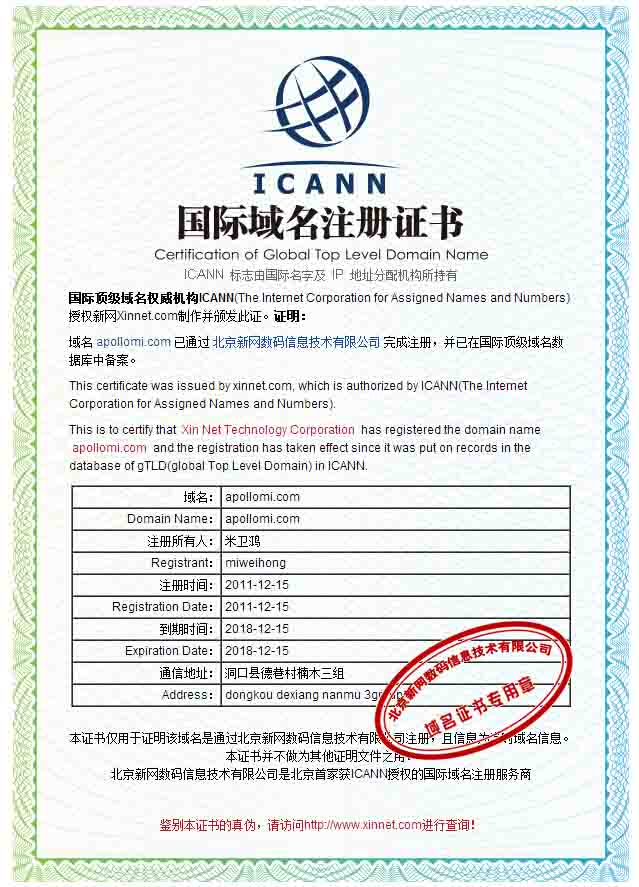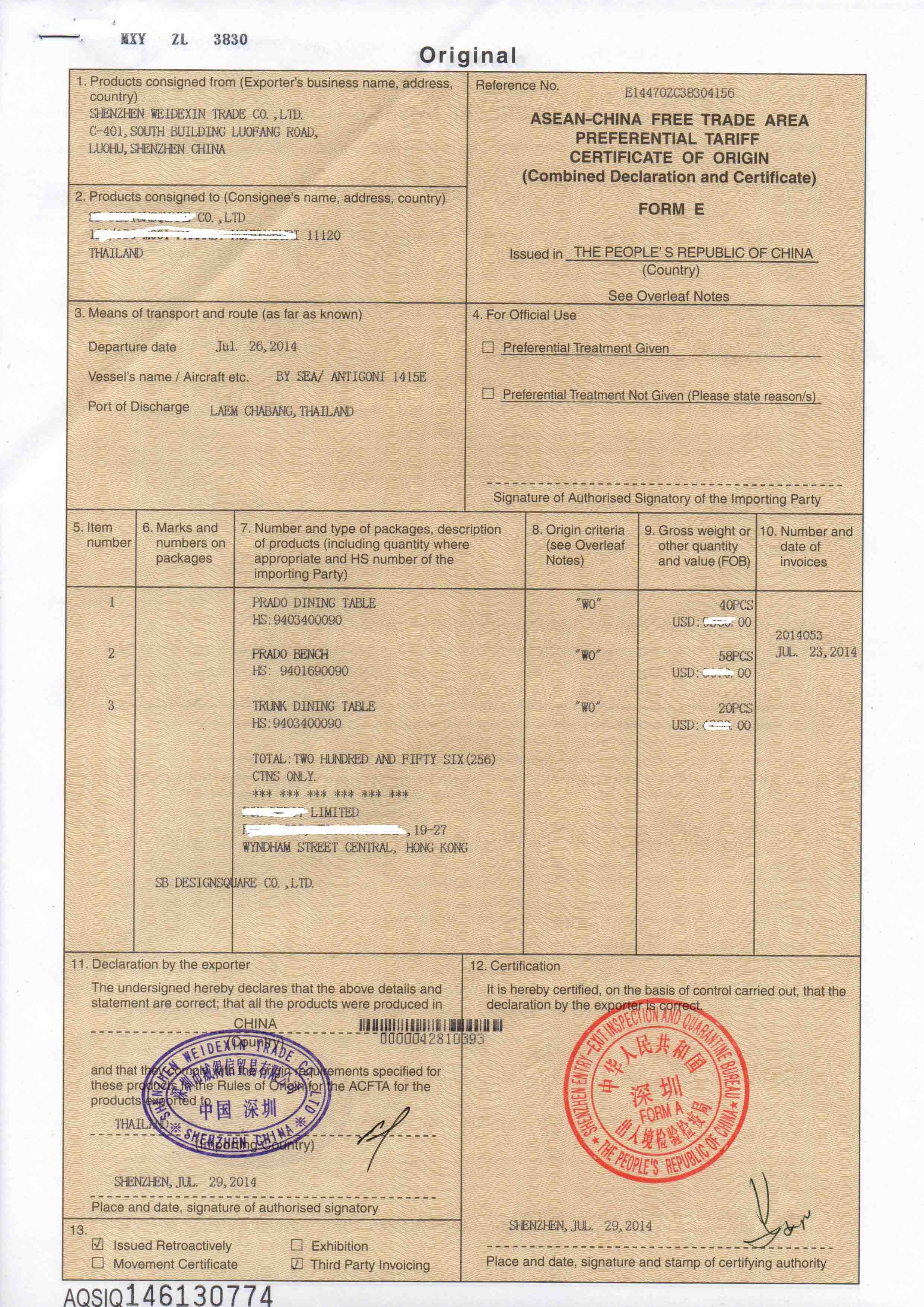LED screen resolution
The key to a quality image on a
However if the LED screen is designed properly it can still give an acceptable appearance for video images. LED screens of approx 1/3 of VGA resolution can provide a very acceptable video image, so around

Modular structure of LED screen, LED module and pixel pitch
Typically, pixel pitches for indoor LED screens are 6 mm, 10 mm, 15 mm and 20 mm. Pixel pitches for outdoor LED screens are 15 mm, 20 mm, 25 mm and 30 mm- outdoor LED screens tend to be larger than indoor screens, as the viewing distance is often greater. We could, for example, use a 6 mm pitch and a slightly bigger LED screen to achieve a full
As most LED screen products come in
At 12 mm spacing the conventional lamps have poor contrast, and produce a lot of heat. The choice of pixel pitch and screen resolution is dictated by: any physical size constraints you may have; viewing distance and sight lines; and, of course, budget - these displays are costed by area.
LED screen color compound distance
When pixels are seen at close range, the RGB light emitting diodes appear as independent dots. The distance from the LED screen where these LED's mix to from a single color is known as the “color compound distance”. Superior color compound ability allows images to appear clear and sharp at close range, which is a vital factor in indoor LED screens. For outdoor lamp-type individual LED screens, the color compound distance can be calculated by the
For indoor surface mounted three-in-one RGB LED devices, this figure is
LED screen minimum viewing distance
This is calculated by the
LED screen maximum viewing distance
This is generally 20-30 times the LED screen height. E.g. A 4.8 meters high screen: 30 x 4.57 m = 137 m.
LED screen video processing
Once you have two competitive LED screens of similar technology, the same size, and the same resolution, the differences in LED manufacturers, drive electronics, and LED mounting methods can be evaluated. A standard video signal cannot be directly displayed on an LED screen without first being processed. It is the quality of this processing, that is most often overlooked by prospective buyers of this technology.
The primary rule of all broadcasting should apply, garbage in = garbage out. Video images are made up of a number of horizontally scanned lines, but these don't all appear on a television screen at the same time. In the first 1/60th of a second (1/50th for PAL) the odd lines are shown, and in the second 60th the even lines are shown.
Everyone's television works this way, and we call this an interlaced display. As most displays don't use this broadcast signal directly, we must first de-interlace the video. The simplest way to do this is to take the first set of lines (field), double it up, and show it - ignoring the second field. Some low-end video processors do this, and throw away half of the original picture information.
More sophisticated approaches involve storing the first line information, and then combine it with the second line information 1/60th of a second later. You can then display a complete frame. However if an object was moving rapidly it may be in a different position in the second line than in the first line and this can lead to unacceptable video effects (flickering).
Resolving this requires interpolation of the two sets of lines, done in real-time and then we have to scale the image to fit the output screen (this is normally a different resolution than the source). The combination of these processes, especially the scaling, requires a lot of powerful processing to generate clean, artifact free, and fast moving flicker free video.
Generally this is done by dedicated video processing equipment, and will be relatively expensive if you want a good result. There are considerable differences in how display manufacturers process the video signal for display, and obtaining this information from the LED screen manufacturers is sometimes not an easy process. It is a very worthwhile endeavor, since the processing can make a dramatic difference to the quality of the displayed image.
LED screen brightness and contrast
The unit of measurement for LED screen brightness is the nit (cd/m2) with higher numbers meaning a brighter display. As a general rule, you will need no less than 1000 nits for an indoor LED screen and 5000 nits or more for outdoor LED screens. The way to measure this is at a normal angle to the LED screen (i.e. in front) using a light meter.
The color temperature of the LED screen should normally be set to 5000K for indoor LED screens, and 6500K for outdoor LED screens. If set this way, a full white signal should be measured at several points (usually 12, being the centre and the then evenly spaced around the LED screen) from the normal minimum viewing distance. The LED screen should be set to black, and then re-measured for the ambient reflected light (one measurement at the centre is OK).
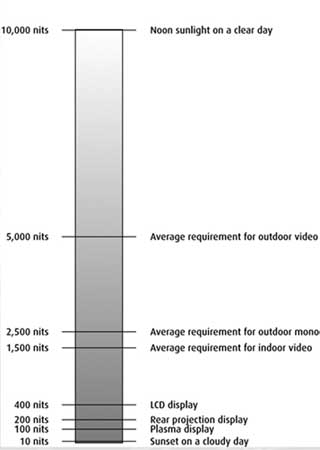 | 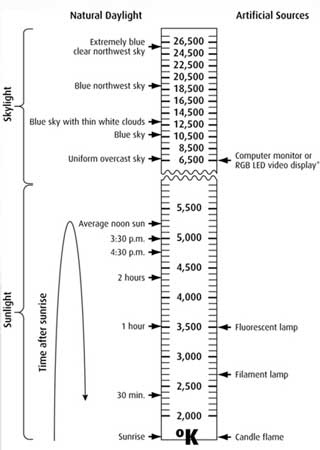 |
| LED screen brightness | Scale of color temperatures |
The LED screen brightness is an average of the 12 points of white, minus the measured ambient when the LED screen is black. The viewing angle is normally defined at the point when the brightness is 50% of the maximum. If you walk around the LED screen you will see the brightness change, and it is advisable to review the three primary colors (and white) when walking around the LED screen to see if the color remains uniform at all angles. LED screens have a problem that is unique to this technology called “shouldering”, where a color shift is caused by one LED blocking the view of another LED at extreme angles.
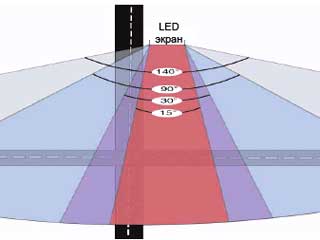 | 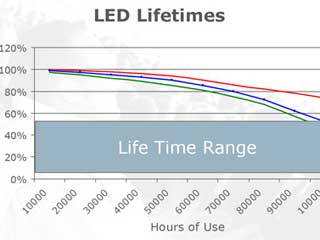 |
| LED screen viewing angles | Degradation in the LEDs |
The viewing angles should really include color shifts, and if a significant color shift occurs before the LED screen brightness falls to 50%, then this is the viewing angle. Adding a louver between the pixels or rows of LEDs reduces the effect of glare from other light sources, and enhances contrast. It also reduces the vertical viewing angle, but usually this is not a problem for most applications. If the LED screen manufacturers drive the LEDs using high currents, they can quote brightness figures in excess of 8000 nits. The problem with this is that high drive currents lead to faster degradation in the LEDs, and the LED screen uniformity can shift dramatically in short periods of time. Quoted life figures for the LED's range from 20 000 to 100 000 hours.
These figures are clearly only meaningful if they are determined at the actual drive current that will be used under real display conditions - and certainly at the drive levels used to produce the LED screen brightness measurement. When evaluating any large-format video LED screen, always ask for references (for both the manufacturer and the installer). Try to ensure that these previous customers are in a similar situation to your own (e.g.: if you have an indoor arena, a comparison with an outdoor venue may not be completely useful).
Before you buy LED screen
- estimate the size and location of your LED screens;
- work out the minimum viewing distances;
- how many and what type of sources will you use;
- will the LED screen be permanent or will it need to move.
Determining these factors beforehand will allow a LED screen manufacturer/supplier to estimate the pixel pitch and nature of the LED screen you may need. When you budget for any screen, and especially an LED screen, you should be aware that without consideration for the content, the final effect will be poor. It is a better idea to determine the content first and use a sample of the content in the format you plan to demo your LED screen. In particular, scenes with a lot of motion and camera pans will create certain LED screen processor problems. Look for objectionable noise artifacts in large expanses of a single color (especially black or very dark areas).
Always remember, the LED screen manufacturer's demo is designed to emphasize the best points about the LED screen, and it is up to you to make them prove how good it really is. Test patterns, for color, grayscale and motion are essential. Take these with you to a demo, in the format you will use with your final LED screen. When you have the final 2 or 3 companies defined, you should give serious consideration to a “shoot out”, with competing LED screens set up side by side- fed from the same source video. While this can be expensive, it is the only way to truly compare the competitor's products. Suppliers reluctant to engage in this kind of event may give you some insight into how confident they are of their product, and what their after sales support will be like!



